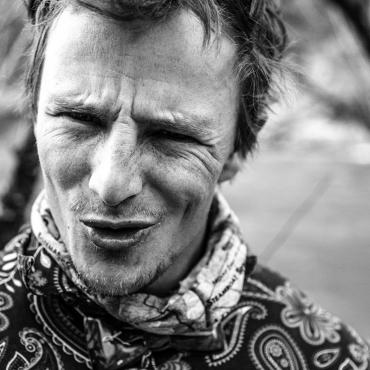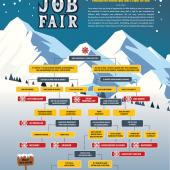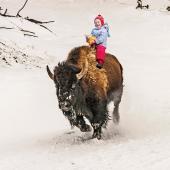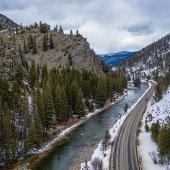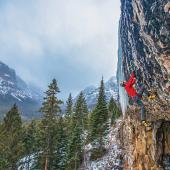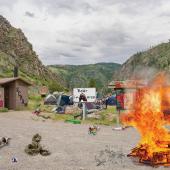Growing Pains
In the ongoing drama of managing the Bozeman boom, Bear Canyon takes center stage.
Tectonic plates are colliding in Bozeman. As people continue to pour in from out of state, the demand for outdoor access has skyrocketed. The dramatic onset of growth, recreation, and management of public lands has brought into question what a proper balance of those things actually looks like. Short of acknowledging some divine precedent, the answer is that it depends on where you stand. But as the number of players involved gets bigger, so do the impacts of every decision. It’s a pressure buildup, and the Bear Creek Trail and Conservation Project is the latest example of just how close we are to the breaking point.
On a cold and windy night in October, Sheila Hepp visits me at the Outside Bozeman office. Hepp’s lived in Bozeman since 1976. She moved to Bear Canyon in 1991 and currently manages various Bozeman properties, including the very building in which we sit. She has the demeanor of a loving mother, with a nurturing voice and a sharp, infectious laugh. Tonight she is fiery, upset, and prepared.
“This one is vile to me,” she says, laying out a manila folder full of emails and opposition letters written to the Gallatin Valley Land Trust regarding the proposed Bear Creek Trail. “I realize there’s a shortage of recreation spots, but it’s a big valley. This is just a narrow, tiny dirt road, and this trail is going to ruin the place.”
She’s referring to an 18-acre parcel of land along Bear Creek, two miles south of the turnoff to Bear Canyon. The property is shaped like a trapezoid, claiming a few hundred yards of creek bottom adjoined starkly with a steep, timbered hillside. In 1998, a man named Paul Gaffney bought it for what he later told me was “dirt cheap.” For 23 years, it’s held nothing but a few corrals and a dilapidated barn. But GVLT recently purchased it, with the intention of opening it up for public access.
“It’s alarming,” Hepp tells me. “The road is unmaintained as it is. This is just going to increase traffic. It’s going to be disruptive in every way.” The reason these 18 acres are such a hot commodity is because it borders a piece of state ground, which abuts the expansive Custer-Gallatin National Forest, providing access to several hundred thousand acres of public land.
I thumb through some of the letters and stop at one from a man named Kurt Prond. Halfway down it reads, “In reality, the public does have [access] in Bear Canyon. Just a mile from this proposed access are two heavily used trailheads—three including Mt. Ellis Lane... Why would GVLT want to create a new impact zone, a fourth trailhead that accesses already accessed terrain when there are already high impacts in the area?” The two trailheads to which Prond refers are Bear Canyon and New World Gulch, and they do see their fair share of traffic. The thing is, the 18 acres in question are being used already, and not just by Paul Gaffney.
In 2007, paraglider Andy Macrae reached out to Gaffney with a request to cross his land to access an optimal launch point on the state ground atop the ridge. Gaffney agreed, and after drawing up a contract with his attorney relieving him of any liability, Macrae and friends were granted access. This was still what Macrae refers to as “the early days of paragliding,” and at the time, the most popular launch spot was Story Hills. Though also privately owned, a great deal of public access was permitted in the Story Hills, including portions of GVLT’s Main Street to the Mountains trail system.
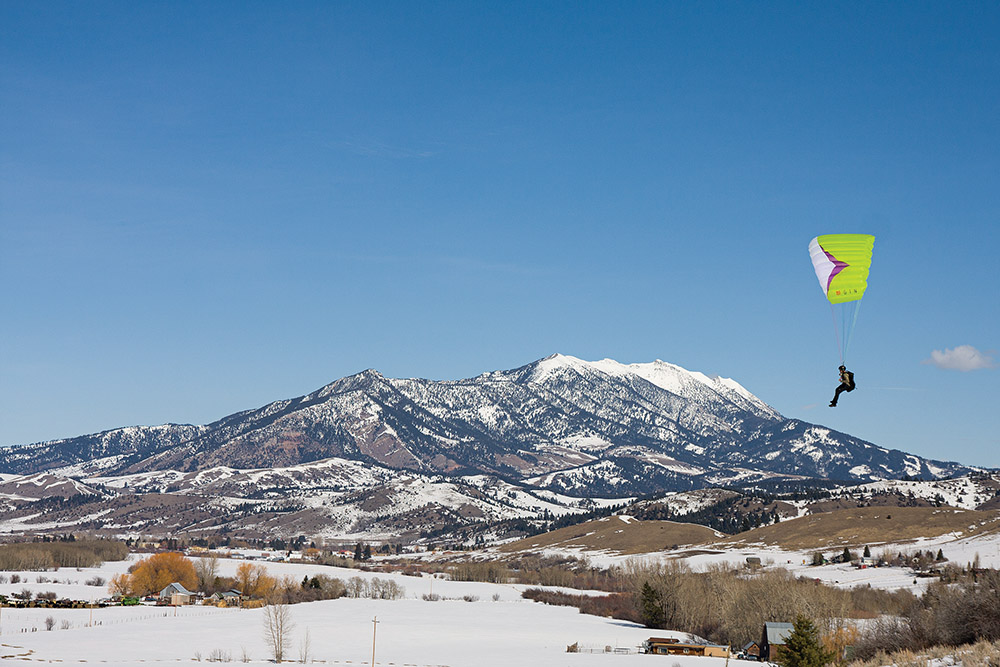
Sailing above the state ground
Macrae guesses that the Bozeman paragliding community (which now tallies around 50 pilots) used Gaffney’s access point for roughly two to three weeks of the year for the first 13 years. This past year, when access to Story Hills got shut down (for reasons unrelated to paragliding), Bear Canyon saw an influx of traffic. And this boost in popularity has people like Hepp looking for any plausible reason to close down public access.
“I’m amazed at the lack of respect for elk by the paragliders,” she says to me, somewhat out of the blue. When I ask her what she means, she can’t seem to find words for it. Indeed, there is an elk herd in the area, and a new trail could be intrusive, but this seems a little too accusatory for anecdotal evidence. Her thought is fleeting, and I get the feeling that what she’s getting at is something much larger than a few guys flying around on public land.Bear Canyon is her home, those animals are her friends, and I get it—change never feels more real than when it happens in your back yard.We spend the rest of the evening reminiscing of the “old days” and lamenting over current growth and development.
Over the next few weeks I continue researching and corresponding with a few other Bear Canyon homeowners, including Doug Harrison, a retired soil scientist. Harrison conducted an independent soil survey compiling USDA and NRCS data, looking at soil composition and watershed health for the area. Over the phone he informs me that Bear Canyon is made up of limestone and cretaceous shale. “When these soils get wet, they move,” he says. “And if it’s steep, they move dramatically.”
He tells me that the costs of drainage and maintenance to avoid erosion will be monumental, should this trail be developed. He says that Bear Creek is already an impaired stream according to the Department of Environmental Quality. But his biggest concern is the impact a trail will have on local wildlife populations. “We see deer, elk, moose, and bear regularly,” he says. “I mean, by all means buy the property and put an easement on it, but don’t develop it.”
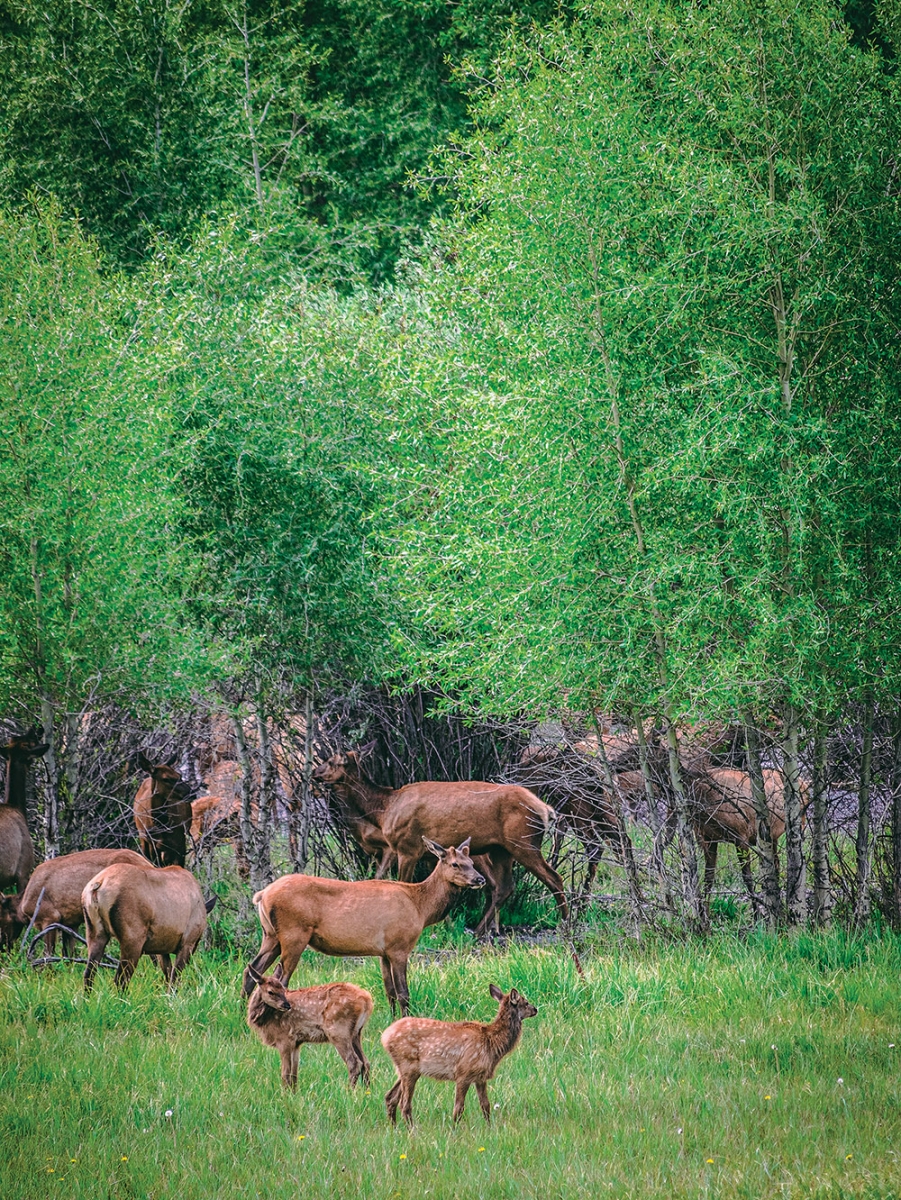
It’s an interesting thought, and when I meet with Chet Work, GVLT’s executive director, on a video call, I make a note to ask him. “There is a possibility that it ends up that way,” Work says. “GVLT will do its absolute best to meet the concerns of the neighboring homeowners while keeping the larger public in mind. Bottom line is that this town is growing and will need more recreation, but more importantly, in areas where trails intersect with habitat, it needs more managed recreation.”
Work joined GVLT in June of last year after 10 years at the helms of the Teton Regional Land Trust in Idaho and the Land Trust for Santa Barbara County in California. I ask him whether he’s received similar pushback to land acquisitions in his past experience. “Some for sure, but not really like this,” he says. He explains that traditionally, land trusts across the country don’t have as big of a trails component as GVLT does, which, he notes, is what attracted him to come here in the first place. “Creation of new trails tends to frustrate the neighbors until they see and benefit from the results,” he says.
We look at maps of the area and he tells me about the assessments they plan to do on soil, water, and wildlife, and that he’d made a pledge to the neighbors to understand and document the use of all three. His voice is genuine and I can’t help but believe his intentions.
“I empathize with all of them. It’s all changing around them,” he says, referring to the runaway growth and demand for increased public access to trails and other recreation areas. “It wasn’t there when they bought their property. It just wasn’t there.”
It’s a sunny January afternoon when I drive down to the property to meet Gaffney for a hike. Joining us will be Brendan Weiner, GVLT’s conservation director. On the way up the canyon I pass a herd of whitetails feeding on the eastern slope. I see small predator tracks of some kind and a bald eagle soars overhead.
Even though it’s only 2pm, by the time I reach the parcel, the entire canyon is in the shade. Gaffney arrives shortly after I do, sporting a bright two-tone ‘90s windbreaker, sleek sunglasses, and a white beard. We make introductions and small-talk, but before he can start telling me about the property’s history, a woman calls at us from her yard across the road.
“Hey! Who are you? Are you with GVLT? If you’re not, you better get off that land. It’s private property.” She’s not wrong. Gaffney signed it over to GVLT the week prior. “Oh, sorry about that,” Gaffney replies. “We have permission and we won’t bother you long.”
“This is GVLT’s land and they don’t want any trespassers,” she insists. “I can call the cops if you like?” We inform her that Weiner is on his way, and she shrugs it off doubtfully. “How are you doing?” I offer. “Beautiful day, isn’t it?”
“It is a beautiful day,” she admits. “But it’d be a lot better if I didn’t have to deal with the two of you talking.” Though we’re 100 yards away, we lower our voices to a whisper.
Gaffney grew up on a family ranch west of Bozeman. Though he’s done a bit of traveling, most of his years have been spent in the Gallatin Valley, living in Sourdough for a stint, then moving to Bear Canyon, which he’s called home for the past 24 years. His house is on a separate piece of ground a half-mile up canyon.
He tells me he first thought of selling this parcel three years ago, which is when he reached out to GVLT. Over time, he talked to various realtors interested in buying, but none of them quite fit his vision.
“The more I thought about it, the more I realized I didn’t want to lose access to the state ground,” he says. “This way, the creek can still be a creek, I can still use it, and the rest of Bozeman can still use it.”
When Weiner pulls up, Gaffney tells me he sold it to GVLT for a lot less than what realtors were offering. “But I wanted access,” he exclaims. “For myself and others. That’s worth dropping the price for. I’ve used trails my whole life. If a result of that is a few upset neighbors, that’s the price I have to pay. I feel perfectly justified with my decision.”
After another introduction, we set off through cottonwoods, aspen, and dogwood. We cross the creek on a board wide enough only for one foot at a time and immediately come to the steep slope. Gaffney hikes in front and though in his late 70s, ambles up the slippery pitch with impressive ease. He becomes giddy as we pass fresh tracks in the snow. “Whitetail here,” he points. “Fox there. No, no, that’s coyote.”
We follow the game trail that the paragliders take to their launch site, which is where GVLT’s new trail, if built, will end. Below us to the west, the ridge spills into an open bowl speckled with ungulate tracks. It’s an obvious landing site, and though I don’t paraglide, from here I can see the appeal. At the south end of the meadow, an aspen patch leads to an unnamed drainage that takes off toward lower Mt. Ellis. It looks like great elk habitat.
Weiner tells me of some illegal trail-building going on in the area. “People are already doing it,” he says. “They will continue to do it, so one of our goals for this project is to manage it better. We want to manage it for recreation, conservation, and for wildlife.”
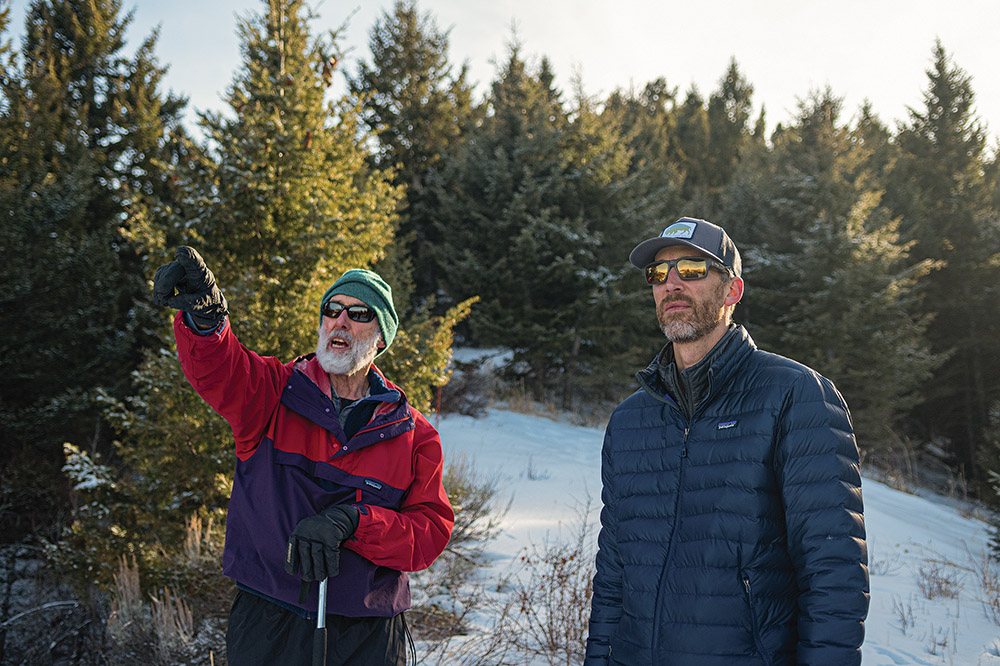
Gaffney shows GVLT's Brendan Weiner around the property
After a short walk up top, Gaffney leads us down into the timber to a flowing spring where he has a game camera set up. “You wouldn’t believe the amount of animals I’ve seen here with this,” he says. “Whitetail, mule deer, elk, moose, lion, bear, fox, coyote. Just about every big critter we have in Montana.” I smile at the thought, but behind him, flags of the proposed trail flap in the wind, and I can’t help but think that once developed and open to the public, a majority of these animals will be pushed elsewhere.
We continue for another hundred yards to a clearing, and one of the only flat spots on the property. There are deer tracks and scat everywhere; they’ve clearly fed here this morning. “This is where your house would be,” Gaffney says hypothetically as if he’d sold it to the realtors. “Do you see why I made my decision the way I did? I have two daughters that hike and bike and use public lands all the time. The last thing I want with my property is another McMansion to be put up.”
It’s a hard argument to disagree with, especially considering the development of the last 20 years. But then I think of Sheila Hepp’s words: “At what point is enough, enough? Go ahead and build a trail, just not here.” I think of the homeowners’ concerns of increased traffic, noise pollution, and wildlife displacement, all of which, on a personal level, seem very valid. But then again, that’s the story of Bozeman. It’s a train too fast to stop, and if not here, then where?
When I’d interviewed Chet Work, he’d told me that he sees this project having “local negatives with regional positives.” He’d said that the Painted Hills connector trail garnered serious pushback too, but that he was confident it was a win for the greater community. As of now, the parcel remains closed to the public. GVLT is carrying out assessments of soil and water quality, as well as wildlife, including possible seasonal closures during elk-calving season. If a trail is built, construction likely will not start until next year.
When we get back to the rigs, we talk a while before going our separate ways. Another bald eagle flies over and lands in a nearby tree. “So,” I look to Gaffney. “Are you going to hike this trail yourself should it all go through?” He pauses for an unusual amount of time before showing his teeth in a wide-eyed grin. “Pretty good chance.”


